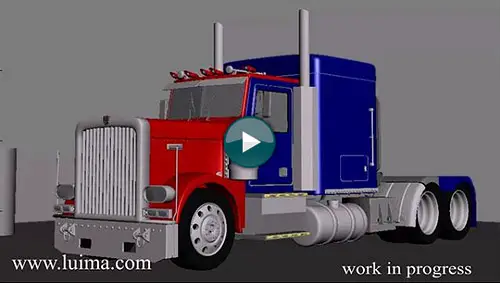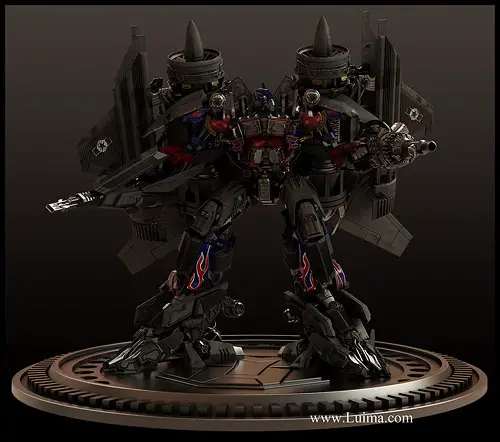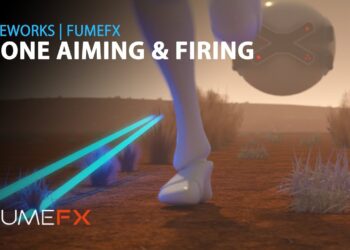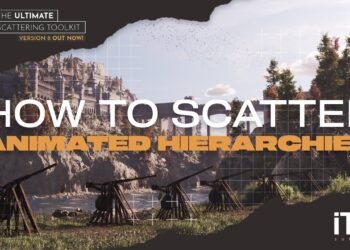Animation
Animation wasn’t as difficult as I expected in terms of logistics. To my own surprise, it was a straightforward process. I checked out some toys for reference and soon figured out a way of doing the overall transformation.
The animation process itself, however, presented some challenges in terms of timing, achieving the flow of mechanical parts moving, sliding over other parts and rotating while maintaining the correct feel of weight. This was a scary task, so I turned to the best reference I could get, “real life”.
Studying how mechanical devices work gave me a starting point, and the transformation animation from the movie itself helped me a lot to overcome the potential issue of weightlessness. Dividing the model into several groups of parts and animating each one on a different scene fortunately worked. This allowed me to handle complex meshes during the animation process. In order to preview the final animation (of the entire model), I merged all the scenes into one and rendered a preview.
(Click on the image below to see an early transformation test video)
For the second animation clip I went for a “japanimation” style that shows the Optimus/Jetfire combination.
Rendering
I started testing render options during the modeling stage. Due to the complexity of the mesh I wanted to have an early idea of what kind of render times I would be facing. The scanline render with two lights and shadowmaps on gave an average time of 18 minutes per frame at 1920×1080. Fairly fast but not realistic at all, so I switched to Mental Ray. With glossy reflections and global illumination turned on, render time increased a lot: almost 10 hours per frame. At this point I was giving up the idea of rendering a complete animation and was thinking of only rendering high resolution stills. A few days later a client asked me to check a new renderer he recently bought, to see if it was possible to use it for a certain production he had in mind. It was the Arion renderer, from RandomControl (makers of Fryrender). The test I did for him was the transformation clip of the Optimus model. Compared to CPU renderers, I found an incredible render time difference. Arion was 50-60x faster than Mental Ray on the same rig. The average time for each frame was 3.5 minutes. The downside was that I had to keep my textures below 1024×1024 pixels. Because of this limitation I had to redo all the texturing work, splitting the high resolution textures into several 1024 textures. Since this renderer does not have displacements, SSS, dispersion and absorption on dielectric materials (glasses), I had to render all these passes in Max (velocity, alpha, transparencies, etc.).
Another issue I faced during the rendering stage was storage, since Arion doesn’t read 3ds max scenes, it converted each animated frame to a separate object. The Max scene was over 1 gigabyte, which means that an animation with 30 frames (1 second) would need 30 gigabytes on disk. I rendered 3000+ frames, you can guess the rest. More than 3 terabytes of animated geometry. When I compared the unbiased quality of the renderer, though, I decided it was the best way to go. The complete time for the entire animation was 5 days with 4 PCs for the diffuse+global illumination pass. When everything was done, I used After Effects to combine all the passes.
(Click below to see the final animation)
Conclusion
Working on a project for a large period of time can be something very difficult if you don’t focus and have the patience and perseverance it demands. I have learned from this project that achieving a vision is something that doesn’t happen overnight in all cases. It started as an experiment, to see if it was possible or not, and to test various techniques. Had I known all the problems this project was going to present, maybe I wouldn’t have dared to jump into it. On the other hand, if that had been the case, I wouldn’t have found out that it wasn’t impossible either. Sharing your work in progress on a forum can be a little scary at the beginning, but it helps you in a lot of ways. The opinions and points of view from other artists are very valuable, and to be able to lose the fear of being wrong is a great thing. Dealing with the opinions and criticisms from others has helped me a lot, because we are constantly learning new things. I have learned from them that we need to keep learning. Sometimes we tend to be satisfied with what we know, but that’s not enough for a real artist. We need to continuously learn new techniques, new tools, new methods, etc., so we can grow in our field, whatever that may be.

Luis Manuel Morillo (Luima) is a self-taught modeler/animator from the Dominican Republic. He decided to learn animation back in 1993, when he watched Jurassic Park for the first time on the big screen, and has been inspired by the work of Industrial Light and Magic ever since. Despite the animation industry in his country being almost non-existent, he opened a small animation studio in 1999 (raycastdr.com) with his brother and a friend. Most commercial opportunities available in his country are small projects, so he tries to challenge himself to keep learning new things, and every time he sees a movie that makes him wonder “how did they do that”, he tries to answer it by finding a way to do it despite all possible limitations. You can find more about his work at www.luima.com.












Very impressive! (-:
this is really amazing, your work is really inspiring!
Amazing, great job !!!
I am an animator and there is never a day that you don’t learn. Thanks for the article. Your work is awesome!
woow buddy… awesome!!!!!
Nossa, muito bom.
awesome woRk dude……really cool modeling and thax 4 sharing this……>>>>>>>>
Thanks for your words guys!! i am really glad you like it , and thanks to maxunderground for the oportunity to share this experience here!.
Best Regards!
Luima.
Man, unbelievable!
My seriously congrats.
Hi Luis, I truly say it’s awesome…great work. I’m also great fan of ILM.
I’m trying to do the same …it’s in progress,meanwhile, I found your post and it is really very helpful to me thanks for that. I’m creating optimus in maya…
I just want to know little bit more about rigging. So please reply me and if you don’t mind plz tell me more about it.It will help me a lot.
THANX…
This is a total overkill. In every single aspect 🙂 I can’t remember seeing a non-commercial work done with so much details!
great jobs,
nice arts
Really is a great project, model can be downloaded?I want to put him into the toy.Or you can say to sell.Thank you very much